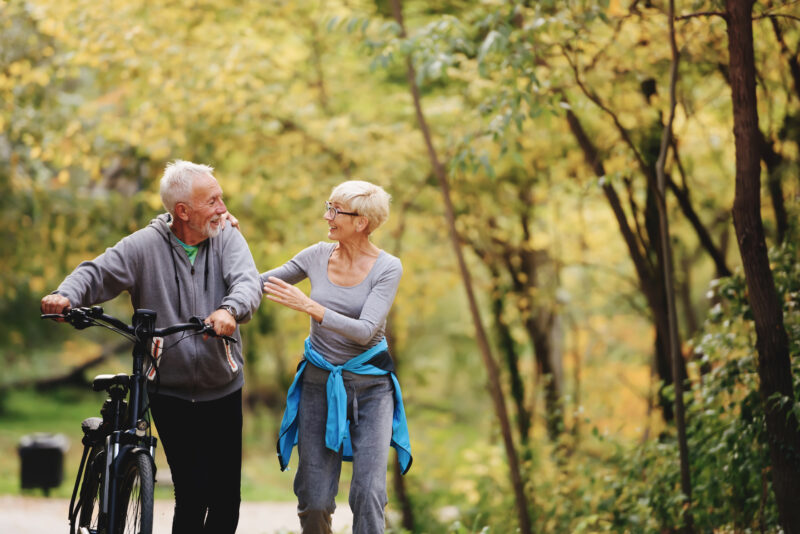As designers, we understand the influence the built environment has on our lifestyle and recognize our responsibility to create environments that foster healthy behavior. This is especially important when designing affordable housing for low-income seniors – an underserved population that is overwhelmingly faced with obstacles to finding safe and affordable housing.
In our approach to designing affordable senior housing, we analyze the specific challenges low-income seniors face. Through literature review and post-occupancy evaluation, we identified the significant challenges statistically encountered by this population. We then determined healthy behaviors that can be promoted through design interventions that effectively address these challenges.
We have identified five keys to designing affordable housing communities that can foster healthy behaviors.
Programming
Intentional programs and supporting design features are crucial to the success of affordable senior communities. By incorporating resident-led activities during the early stages of design, the opportunity arises to include cost-effective features that encourage frequent use. These features can be as simple as a handwash sink and hose bibb connection in an outdoor space for residents to garden or gather for meals with easy cleanup. Flexible spaces with amenities like a TV, movable seating, and a kitchenette foster social interactions, physical activity, and a sense of belonging. These seemingly small features can lead to significant achievements in terms of community engagement and overall well-being.
Connection to Nature
Design features that connect the interior to nature, including operable windows that allow natural light, thermal comfort, and landscape views, have a positive impact on resident health.
It’s important to offer easy and safe access to outdoor spaces, whether through built amenity areas or existing neighborhood features like parks and trails. Seniors often avoid going outside due to safety concerns, so the design of the outdoor environment plays a crucial role in making them feel comfortable and secure. Design strategies such as flush thresholds, lightweight doors, visual access, and covered seating areas give residents the confidence to go outside regularly and engage in behaviors that promote healthy long-term aging.
Inside/Outside Relationship
Humans have an innate need to connect with nature. Successful outdoor amenity spaces (porches, terraces, etc.) offer a fluid and safe connection between inside and outside. Incorporating this connection gives residents choices in how they experience the outdoors and offers benefits including stress reduction, improved cognitive health, and enhanced immune function.
Complementary inside and outside programming is critical to maximizing the success of each space. For instance, connecting an outdoor patio with flexible seating to an indoor lounge with similar features creates a cohesive, inviting, safe, and flexible space that can be used for different purposes and weather conditions. When indoor and outdoor spaces share a cohesive program, residents are more likely to use and enjoy them, enhancing their overall experience.
Site Selection
The location of an affordable senior housing project will impact the residents’ community engagement and physical activity. While recreational walking isn’t for everyone, seniors are likely to engage in purposeful walking, such as going to a store or the senior center. Short, safe, and comfortable walking routes increase daily, weekly, and yearly exercise. Research shows that increased walking promotes outdoor time, spontaneous interactions, improved physical and emotional health, and slowed cognitive decline.
The 5-minute walk is a staple of urban planning and adaptable to different age groups, including seniors. The average age of seniors in subsidized housing is 79, and a person of that age can walk approximately 0.18 miles in 5 minutes. It’s important to consider this during site selection and choose a location within a 0.18-mile walking distance to amenities commonly used by seniors. The location itself will foster a healthy lifestyle by encouraging regular walking among residents as they access these amenities.
Choice
Senior living communities must balance social interaction with privacy and independence. Logically, if residents have more choices, they are more likely to engage with their environment. Outgoing residents might prefer a large, busy terrace, while introverted residents will gravitate towards smaller, intimate spaces.
On a larger scale, offering comfortable walking route options without barriers will increase the likelihood of residents venturing out regularly. This promotes regular physical activity and helps prevent negative health impacts such as disabilities and social isolation. Providing choices in both destinations and circulation encourages repeat use of spaces, leading to increased physical activity as seniors travel to different areas within the community.
Conclusion
While we can’t solve all problems through design, we can find impactful solutions that create healthy physical environments and ease the challenges faced by low-income seniors. By embracing a thoughtful and intentional approach, we can create affordable housing communities that promote healthy behaviors and positively influence the health and wellness of low-income seniors.
